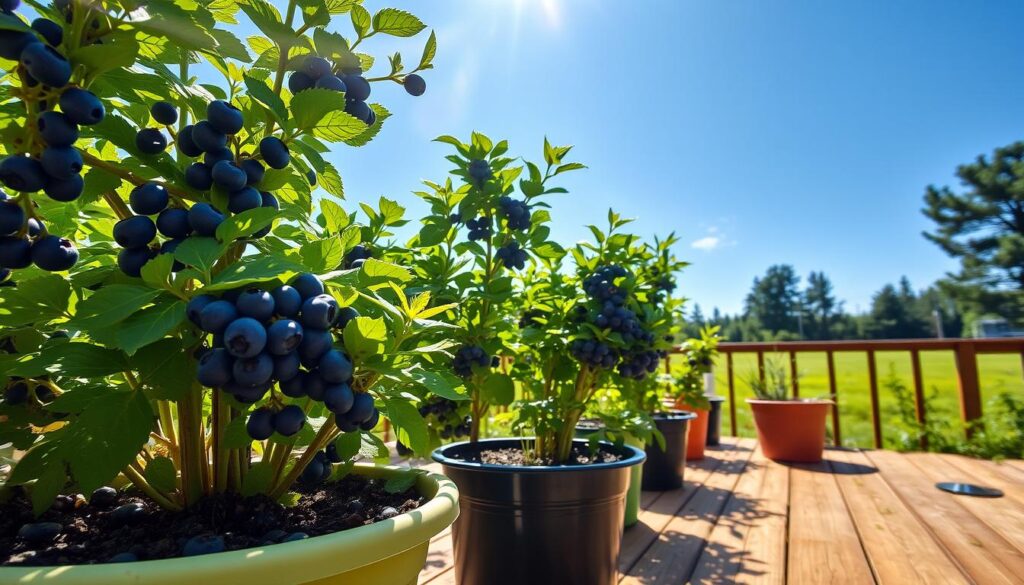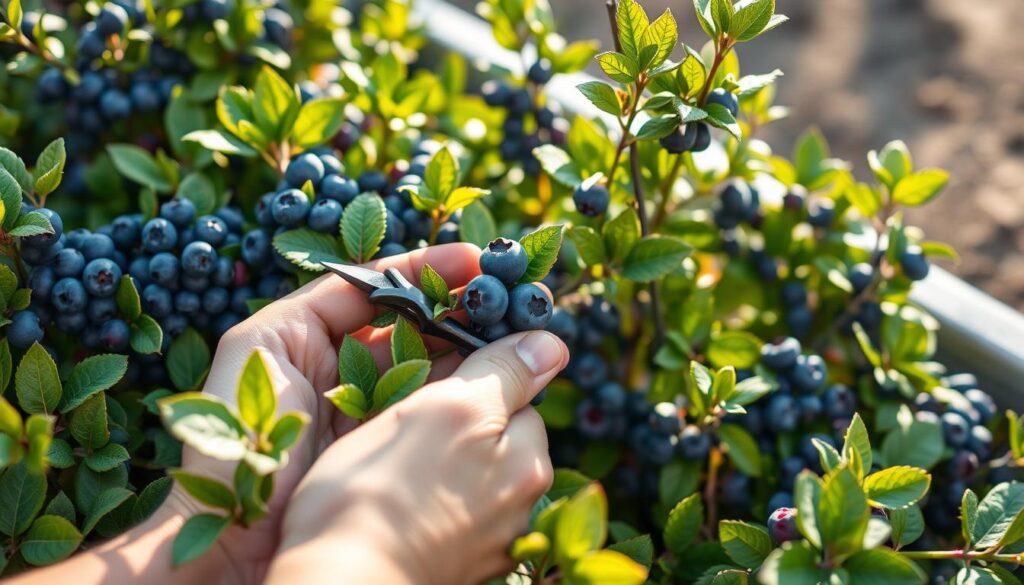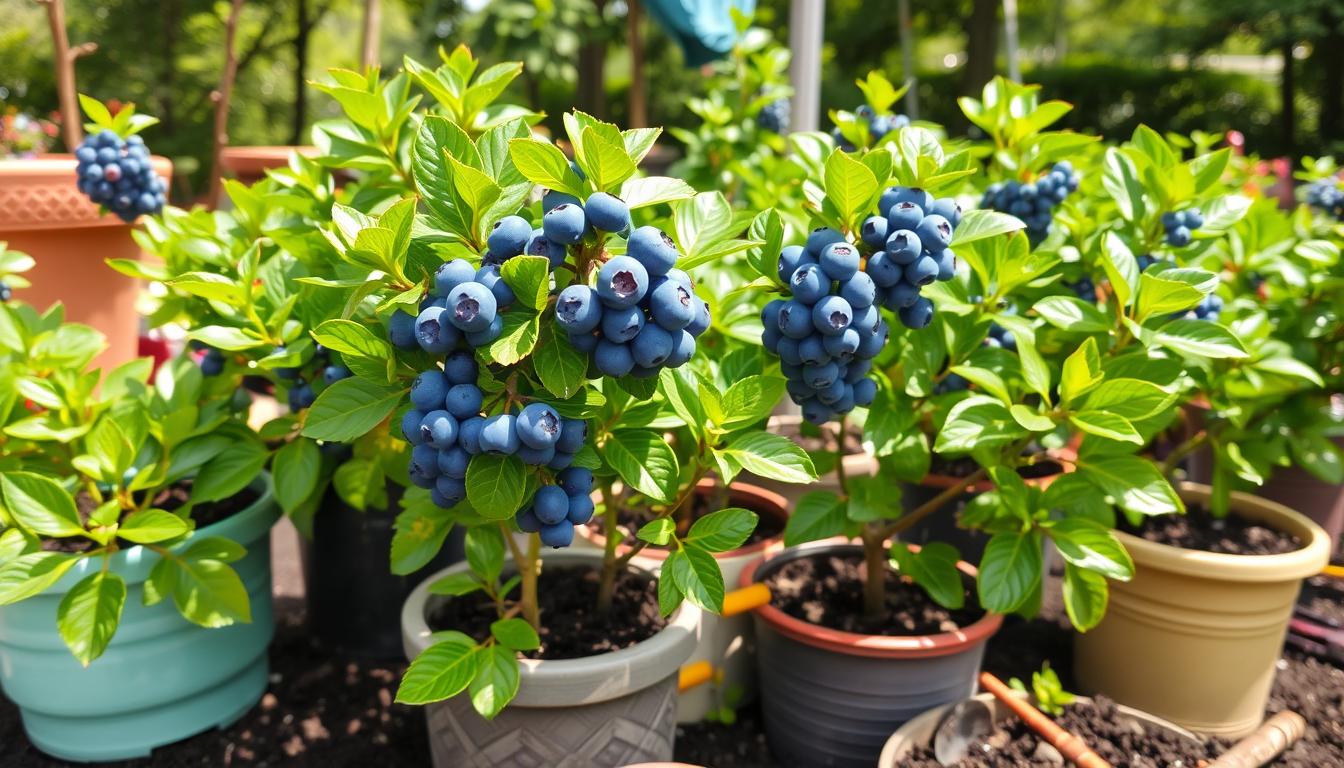Growing blueberries in containers is a rewarding hobby. It lets you enjoy fresh berries right at home. In this article, I’ll share key tips for growing blueberries in pots. You’ll learn about their care needs, common mistakes, and how to pick the best varieties.
Discover how to keep your soil just right and ensure your blueberry plants thrive. Follow these expert tips to grow blueberries in containers successfully.
Key Takeaways
- Blueberries thrive in well-drained, acidic soil with a pH range of 4.0 to 5.5.
- Consistent watering is crucial, especially during the first year of growth.
- Select compact blueberry varieties for optimal container gardening success.
- Regular soil testing helps maintain the ideal growing conditions for blueberries.
- Incorporating organic matter like compost enhances blueberry plant health.
- Cross-pollination between different blueberry cultivars boosts fruit production.
Introduction to Blueberry Container Gardening
Blueberry container gardening is a great way to grow these tasty fruits, even with little space. By growing blueberries in pots, I can control the environment better. This is key for their success.
It’s easy to keep the soil just right for blueberries in pots. They need a pH between 4.0 and 4.8. This way, I can make sure the soil is perfect for them to grow.
When growing blueberries in pots, I place them in spots with lots of sunlight. They need six to eight hours of sun a day. I also pick varieties that do well in containers, like ‘Top Hat’ for cold places or ‘Sunshine Blue’ for warm ones.
Keeping the plants healthy is important. I make sure to check the soil and give them the nutrients they need. This is part of Blueberry plant care.
To get good yields, I use big containers, at least 5-10 gallons. Half wine barrels are great for bigger plants. Taking care of the soil, managing pests, and watering well are all part of the job.
By following these steps, I get to enjoy the fruits of my labor. It turns gardening into a fun hobby.
Why Choose Container Gardening for Blueberries
Container gardening has many benefits for growing blueberries. It lets you control the soil better. This is important because bad soil can slow down plant growth. With pots, you can make the perfect soil for blueberry bushes.
Another great thing about growing blueberries in pots is how easy it is to move them. You can put them in the best spot for sunlight and water. I’ve seen how moving them can really help the plants grow better.
Blueberries love sunlight and need soil that’s sandy and drains well. The soil’s pH should be between 4.0 and 4.8. Pots make it easy to keep these conditions right. Just follow these Container Gardening Tips for Blueberries to help your plants grow well.
It’s also easy to keep the soil moist in containers. Blueberries need about 1 to 2 inches of water a week. You can see how wet the soil is, so you won’t overwater.
Using pots also makes it easier to fight pests. You can spot problems fast and fix them. This keeps your plants healthy and helps them grow lots of fruit.
How to Grow Blueberries in Containers
Growing blueberries in containers is a rewarding hobby. It’s important to know what blueberry plants need to grow well. They do best in certain conditions, so it’s crucial to get it right from the start. Here are some Container Gardening Tips for Blueberries to help you succeed.
Understanding Blueberry Needs for Container Success
To start a successful blueberry container garden, you need to meet their needs:
- Blueberry plants need six to eight hours of sunlight daily for optimal growth.
- They prefer acidic soil with a pH range of 4.0 to 5.0, crucial for nutrient absorption and fruit production.
- Moisture levels must be consistent, avoiding waterlogged soil that can harm the plant’s roots.
- Choose containers that are at least 18 inches deep to accommodate their shallow roots.
Benefits of Container Gardening for Blueberries
Container gardening has many benefits for blueberries:
- Effective pest management is more achievable as the plants can be moved to less vulnerable locations.
- Access for care tasks, including watering and fertilization, becomes easier with containers.
- Creating custom soil mixtures tailored to blueberry needs is straightforward when using pots.
- Bird netting can protect the plants, as pots on patios are less likely to attract feathered pests.
To have a thriving blueberry container garden, it’s important to provide the right conditions. Knowing how to care for the plants is key to a bountiful harvest.
Selecting the Right Blueberry Varieties for Containers
Choosing the right blueberry variety for containers is key for a great gardening experience. With container gardening on the rise, picking compact varieties boosts yield and keeps plants small. It’s important to think about chill hours, yield, and ripening seasons when picking.
Compact Blueberry Varieties Suitable for Pots
Many compact blueberry varieties do well in containers. Here are some top picks:
| Variety | Chill Hours Required | Zone | Ripening Season | Yield |
|---|---|---|---|---|
| Bushel and Berry™ Pink Icing | 500 | 5-10 | Mid-summer | Moderate |
| Patriot | 800-1,000 | 3-7 | Early: Mid-End of July | High (10-20 lbs) |
| Bushel and Berry™ Peach Sorbet | 300 | 5-10 | Mid-summer | High |
| Sunshine Blue | 150 | 5-10 | Mid-season: End of May-End of June | Moderate (5-10 lbs) |
| Northsky | 800+ | 3-7 | Mid-season: Mid-End of July | Small (up to 2 lbs) |
| Bushel and Berry™ Jelly Bean | 1,000+ | 4-8 | Mid-summer | High, bumper crop |
Cross-Pollination for Better Yields
Using cross-pollination in blueberries greatly increases berry production. Planting at least two different cultivars is recommended to enhance yields. A mix of early, mid, and late-season varieties extends the blueberry harvest period, providing fresh berries from late spring to mid-summer.
Choosing the Best Soil for Blueberries in Pots
Growing blueberries in pots needs careful soil choice. The best soil must be acidic to help plants grow well. Blueberries need a pH between 4.5 and 5.0. Good soil supports roots, holds water, and gives nutrients.
Importance of Acidic Soil
Acidic soil is key for blueberries. The wrong pH can stop them from getting nutrients. This leads to weak growth and less fruit.
Testing soil often is important to keep it acidic. You can buy acidic soil mixtures or make your own. Mix peat moss and potting soil for acidity and drainage.
Creating Your Own Soil Mixture
Making your own soil mix is rewarding. Use 40% peat moss, 10% compost, and 50% native soil. This mix is full of organic matter good for blueberries.
To adjust pH, add elemental sulfur or ammonium sulfate. Mulching with pine needles or wood chips keeps moisture and acidity. For more gardening tips, visit GardenBeginner.com.
Container Size and Material Considerations
Choosing the right container size and material is key for growing blueberries in containers. The right size container looks good and helps plants grow well. It gives them enough room for their roots to spread and absorb nutrients.
Proper Container Dimensions
For blueberries, look for containers that are at least 18 to 24 inches wide and deep. This size is perfect for their shallow roots. As they grow, consider moving them to bigger containers, like half wine barrels, to support their growth.
Best Materials for Containers
Choosing the right material for your container is important. It affects how well the container lasts, keeps heat out, and absorbs it. Here are some good options:
- Plastic: It’s light and easy to move, great for getting your plants in the right sunlight.
- Ceramic: It keeps the temperature steady but might break if it gets too cold.
- Wood: It looks nice but make sure it’s not treated with harmful chemicals.
- Metal: It’s strong but can get too hot, which might harm the soil.
No matter what you choose, make sure your container has drainage holes. This stops water from pooling and keeps the roots healthy. By picking the right size and material, you’ll help your blueberries grow strong and produce well.
Watering Techniques for Blueberries in Containers
Watering is key for Blueberry Plant Care, especially in containers. Container gardening needs careful soil moisture attention. Blueberries’ shallow roots dry out fast, making good watering techniques crucial.
Understanding Water Requirements
Blueberries in containers need water every day during the growing season. When it’s over 100°F, they need water twice a day. A regular watering schedule keeps berries plump and juicy, boosting harvests.
Tools for Monitoring Soil Moisture
Soil Moisture Monitoring is vital. I use moisture meters to check soil dampness. Checking the topsoil helps me know when to water more. These tools help avoid overwatering, which can harm roots.
| Watering Schedule | Temperature Range | Recommended Frequency |
|---|---|---|
| Normal Conditions | Below 100°F | Once Daily |
| Heat Wave | Above 100°F | Twice Daily |
| Cooler Months | Variable | 2-3 Times a Week |
Sunlight Requirements for Blueberry Growth
To grow blueberries in containers, knowing their sunlight needs is key. Blueberries need at least 6 to 8 hours of full sunlight each day. This light helps them grow well and produce more fruit.
When picking a spot for your blueberry containers, choose a sunny area. This is important for their growth and fruit. The right spot can really help your blueberries thrive.
If you want to learn more about blueberry care, check out this guide. It’s full of useful tips for gardeners at any level.

| Sunlight Exposure | Impact on Growth |
|---|---|
| Less than 6 hours | Poor fruit production, weakened plants |
| 6 to 8 hours | Optimal growth and fruiting |
| More than 8 hours | Possible stress; monitor moisture |
In short, making sure blueberries get enough sunlight is vital for growing them in containers. With enough light, they’ll be healthy and give lots of tasty fruit.
Fertilizing Blueberry Plants in Containers
Fertilizing blueberry plants in containers is key to their health and fruit production. Knowing how to fertilize them right can boost their growth and fruiting. Choosing the right fertilizer and knowing when to apply it are crucial steps.
Choosing the Right Fertilizer
Blueberry plants need specific nutrients to thrive. They do best in soils with a pH between 4.5 and 5.1. It’s important to pick fertilizers that keep this acidity level.
Organic fertilizers like blood meal, seaweed, and bone meal are great for acid-loving plants. Ammonium sulfate is a top choice, with 2 to 4 ounces per bush annually recommended. Slow-release fertilizers, like elemental sulfur, are also good for organic gardening.
When and How to Fertilize
Timing is everything when fertilizing blueberries. The best time is early spring, when they start growing. Fertilizing three times during the growing season is best.
The first application is when new growth starts. The second is six weeks later, and the third is right after harvest. This schedule helps them get the nutrients they need without getting too much.
| Fertilization Timing | Recommendation |
|---|---|
| Early Spring | First application when new growth begins |
| Mid-Growth (6 weeks later) | Second application |
| Post-Harvest | Third application |
It’s important to check the soil’s pH and nutrient levels often. Soil tests every 4 to 5 years help keep the soil just right for blueberries. Knowing about nitrogen, phosphorus, potassium, and micronutrients helps with fertilizing.
Common Pests and Issues in Blueberry Container Gardening
Keeping blueberry plants healthy in containers has its own set of challenges. Pests in Blueberry Gardening are a big problem. It’s important to know how to deal with pests like blueberry maggots and Japanese beetles. This will help protect your garden.
Identifying Common Pests
Many Common Blueberry Pests can harm my plants. Here are some of the most common ones:
- Blueberry Maggots: These are the larvae of the blueberry fruit fly. They can cause a lot of damage from June to August. Adults lay up to 100 eggs in just one month.
- Blueberry Gall Midges: These pests eat young blueberry shoots. Their adult stage is very short, lasting only two days.
- Blueberry Stem Borers: These pests burrow into stems for winter. They harm not just blueberries but also azaleas and rhododendrons.
- Japanese Beetles: These pests have shiny green bodies and bronze wing covers. They start appearing in June and can eat up entire plants.
Preventative Measures for Healthy Plants
There are ways to prevent Blueberry Plant Issues. Here are some steps I take:
- Physical Barriers: Using netting can keep birds away from blueberries.
- Regular Inspections: Checking plants often helps catch pests early.
- Botanical Insecticides: Products like Pyganic Gardening Insecticide work well against pests. Make sure to apply it thoroughly.
- Pruning and Sanitation: Cutting off affected areas and removing host plants helps control pests like the blueberry stem borer.
By being careful and using these methods, I can keep pests away. This helps my plants stay healthy and produce more fruit.
Over-Wintering Blueberry Bushes in Containers
Over-wintering blueberries in containers needs careful planning. Potted blueberry bushes face unique challenges to protect their roots from cold. It’s crucial to provide them with the right winter care to help them thrive come spring.
Winter Care Guidelines
To protect blueberry plants from freezing, several strategies are key. Here are some methods for the best cold climate care:
- Move the container to a sheltered area where temperatures remain cool but above freezing.
- Bury the pot in mulch or soil for added insulation against harsh winter conditions.
- Cover the plants with lightweight fabric or burlap to protect them from extreme cold winds.
- Adjust watering frequencies to maintain soil moisture without oversaturating, since the plants have reduced water requirements in winter.
Ensuring Plant Survival in Cold Climates
Blueberry bushes are hardy but need care to survive. Regular checks during winter help monitor their health. Dormant plants might look dead but will revive when it gets warmer.
Knowing your plant’s hardiness zone is key. For example, Rabbiteye blueberries need chill hours below 45°F to prepare for the next season.
With the right preparation and care, my blueberries not only survive but thrive. A good winter care plan boosts their growth in the next seasons. For more tips, check out this relevant resource.
| Method | Description |
|---|---|
| Move to Sheltered Area | Position the container where it receives less wind and maintains cool temperatures. |
| Bury in Mulch | Insulate the pot by burying it in mulch or soil, protecting the roots from extreme cold. |
| Cover the Plant | Use burlap or fabric to shield blueberry bushes from harsh winds and frosts. |
| Adjust Watering | Reduce watering frequency while keeping the soil moist to prevent root rot. |
Pruning and Maintenance for Healthy Growth
Keeping blueberry plants healthy and productive depends on regular pruning and care. Proper Blueberry Plant Maintenance leads to a strong yield. It also helps shape the plant for better sun and air.
Many gardeners miss the importance of this step. Yet, it’s crucial for healthy blueberry growth.
Importance of Regular Pruning
Pruning blueberries is key to removing dead or diseased branches. These can block healthy growth. In winter, I prune back unwanted growth to encourage new fruit.
This practice boosts airflow and fruit production. Healthy pruning leads to more fruits, helping my plants thrive.
When to Prune and How to Do It
The best time to prune blueberries is in late winter, before they bud. I cut off lower growth and dead stems to keep the plant clear. Using sharp tools helps the cuts heal better and prevents infection.
For successful blueberry cultivation, learning Pruning Blueberries is essential. If you want more tips on caring for your blueberries, check out here.

Conclusion
Successful blueberry container gardening is rewarding and practical. I’ve learned the key steps, from picking the right varieties to managing pests. These steps help grow blueberries in containers, making homegrown fruit a reality.
Blueberry bushes do well in containers, even in small spaces like balconies. They need containers that are at least 18 inches wide. With the right care, like keeping the soil acidic and moist, they thrive.
Blueberries add beauty and flavor to any garden. They make outdoor spaces lively and provide tasty berries for cooking. I highly recommend container gardening for blueberries for those who want to grow their own fruits.



Leave a Reply